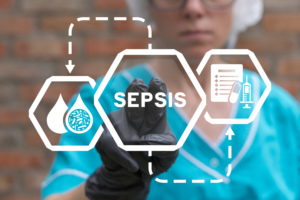Setting Up a Best-in-Class Sepsis Protocol with Cutting Edge Technology
When a patient arrives at the emergency department (ED) with chest pain, they undergo a standard triage process and receive a standard diagnostic workup, ensuring consistency in care across hospitals nationwide. Yet, when a patient presents to the ED with signs of infection, their experience can vary dramatically depending on the hospital. Why? Because, until now, there has been no universal protocol for holistic sepsis care, from early detection to treatment. Cytovale is changing that. Our groundbreaking technology, IntelliSep, is a blood test that analyzes immune activation to detect sepsis in approximately eight minutes. In partnership with hospitals, we help implement this technology alongside standardized screening processes and clinical pathways, ensuring every patient at risk of sepsis experiences the same triage process, gets a standard diagnostic workup, and receives appropriate care. This not only reduces clinician bias and care variability but also drives better patient outcomes. The future of sepsis detection is here—and it’s transforming emergency care.
What is a sepsis protocol?
A sepsis protocol is a structured, evidence-based process used by clinical teams to rapidly identify and manage patients at risk of sepsis. It outlines clear steps and timelines to facilitate early and accurate diagnosis while providing specific guidelines for appropriate treatment interventions.

What is the purpose of a sepsis protocol?
Sepsis protocols streamline workflows, helping healthcare providers recognize sepsis early and initiate timely treatment or rule out sepsis and pursue alternative diagnoses, which is critical for improving patient outcomes. There are several key benefits to using a sepsis protocol:
- Early recognition: For every hour that sepsis goes untreated, the risk of mortality increases by up to 9%. A sepsis protocol ensures consistency in early identification of patients with sepsis and better outcomes.
- Prioritized Care: ED overcrowding has led to longer ED boarding times and more patients leaving without being seen. Protocols help care teams rapidly identify high-risk patients, ensuring they receive timely attention, while also providing confidence to safely discharge low-risk patients. This alleviates the strain on healthcare providers and helps reduce burnout.
- Faster treatment: Research shows that timely administration of fluids and broad-spectrum antibiotics is crucial to improve outcomes in sepsis. Protocols eliminate the guesswork and unnecessary delays in care, ensuring this evidence-based care is delivered every time.
- Standardized care: Sepsis presents differently in each patient, making diagnosis challenging—even among experts, who often disagree on risk assessment. Protocols reduce variability, minimize bias, and ensure equitable treatment while also improving quality metrics like SEP-1 compliance.
What are the elements of a sepsis protocol?
The most well-known sepsis protocol today is SEP-1, which emphasizes early recognition and early intervention with life-saving therapies. It outlines clear time frames for blood cultures, serial lactate measurements, antibiotic therapy , fluid resuscitation, and vasopressors. However, an effective sepsis protocol extends beyond SEP-1. Here are the key elements of a comprehensive approach:
- Screen the right patients: Sepsis can be difficult to recognize due to its heterogeneous presentation. It’s important to know which patients should even be evaluated for sepsis. Integrating sepsis screening into standard nurse triage helps ensure no patient is overlooked. Screening criteria typically combine vital signs with other risk factors to identify patients needing further evaluation.
- Standardized Diagnostic Workup: Rapid and consistent diagnosis is essential. While tests like procalcitonin, lactate, and blood cultures have traditionally been used, they were not designed for sepsis detection or exclusion. IntelliSep is the first and only blood test that is FDA cleared for early sepsis detection in the ED.
- Risk stratification: Sepsis can escalate quickly to severe sepsis or septic shock, making it critical to determine patient risk. A protocol should help providers identify high- and low-risk patients to prioritize care effectively. With a 98% NPV and 56% PPV, IntelliSep provides confidence in ruling out or ruling in sepsis.
- Guided Treatment Pathways: A protocol should outline appropriate next steps for patient care based on sepsis risk. Cytovale collaborates with hospitals to develop standardized care pathways for different IntelliSep results, ensuring high-risk patients, low-risk patients, and those in the middle with possible sepsis all receive appropriate care.
- Ongoing monitoring: Continuous assessment is essential to track patient progress and adjust treatment as needed. A sepsis protocol should specify how providers should monitor and respond to changes over time.

Early sepsis detection with clear, actionable results
IntelliSep empowers providers with an unprecedented view into the biology of sepsis. Leveraging microfluidics, computer vision, high-throughput image analysis, and machine learning, the Cytovale System measures immune activation—a key indicator of sepsis. The IntelliSep test, run on the Cytovale System, stratifies patients based on their likelihood of having sepsis, delivering clinically actionable results in about 8 minutes. These results are presented as a numerical value and categorized into three discrete risk bands, providing a rapid, objective measure to support timely and accurate diagnosis within the ED workflow.
Early adoption of IntelliSep at a 900-bed academic medical center in Louisiana, has demonstrated significant clinical, operational, and financial benefits. When implemented as part of a structured protocol, this organization found that within the first 90 days IntelliSep helped reduce inappropriate use of resources, shortened length of stay by 1.28 days, lowered hospital costs by $1,400+ per patient tested, and accelerated time to treatment for high-risk patients by over an hour.
Beyond the data, the human impact is undeniable. As one patient shared: “The IntelliSep test helped identify my sepsis early, leading to immediate and necessary treatment. I believe the test was crucial in saving my life. I can’t speak highly enough of it—and I can’t imagine a hospital not having it.” By providing fast, reliable, and objective sepsis detection, IntelliSep is transforming emergency care and helping save lives.
For more information about IntelliSep and how to embed it in your sepsis protocol, reach out to Cytovale at info@cytovale.com.